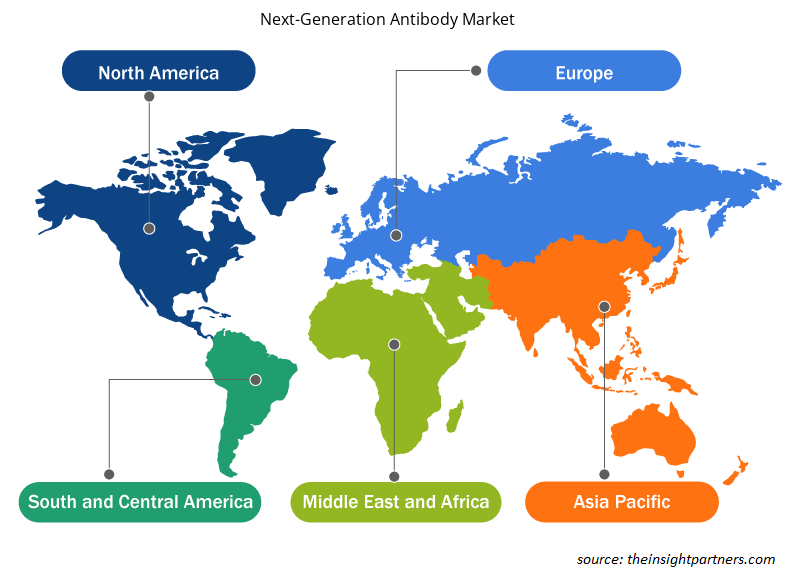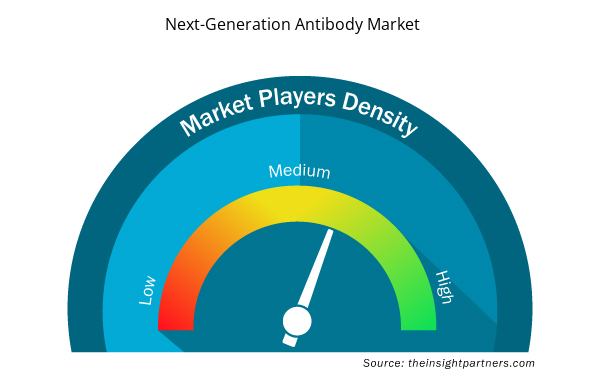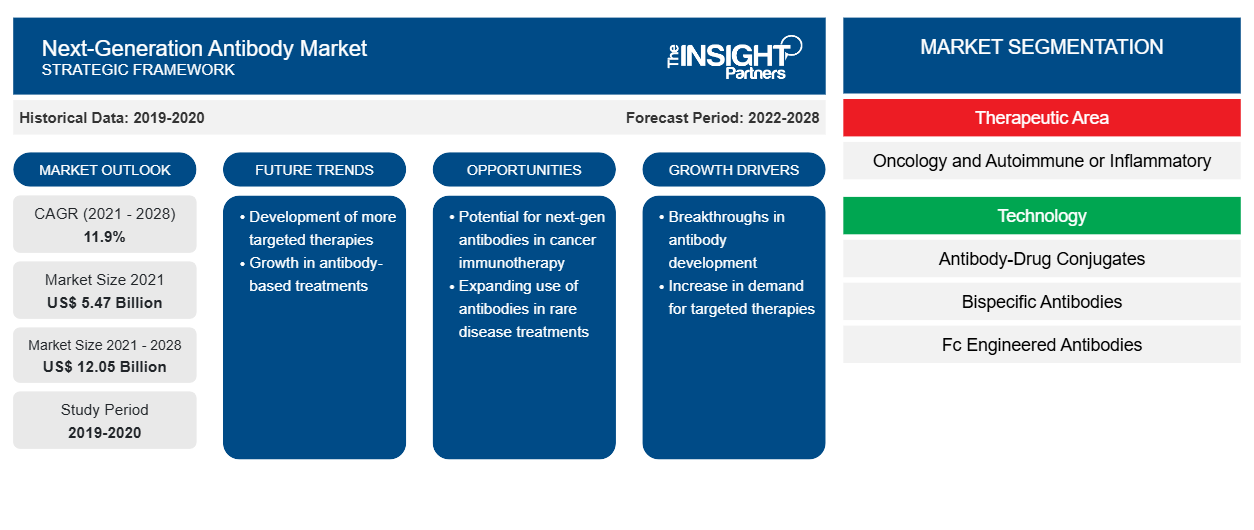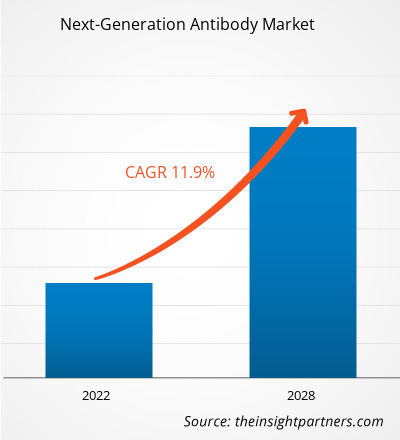下一代抗体市场预计将从 2021 年的 54.6841 亿美元增至 2028 年的 120.5013 亿美元;预计 2021 年至 2028 年的复合年增长率为 11.9%。
新一代抗体旨在比传统单克隆抗体更具特异性,而且通常更有效。新一代抗体策略需要设计一种有用的治疗药物,结合抗体、有效载荷、连接子和结合方法,同时确保稳定性、靶向递送和有限的脱靶效应。
该报告提供了对下一代抗体市场的见解和深入分析,强调了各种参数,例如市场趋势、技术进步、市场动态以及全球主要市场参与者的竞争格局分析。它还包括 COVID-19 大流行对所有地区市场的影响。这场大流行扰乱了世界各国的社会经济状况。目前,根据世界卫生组织最近的统计,美国是世界上受 COVID-19 疫情影响最严重的国家,确诊病例和死亡人数位居全球首位。大量的 COVID-19 阳性病例对全球经济产生了负面影响。全球整体商业活动和各行业的增长都有所下降。
定制此报告以满足您的需求
您可以免费定制任何报告,包括本报告的部分内容、国家级分析、Excel 数据包,以及为初创企业和大学提供优惠和折扣
- 获取此报告的关键市场趋势。这个免费样品将包括数据分析,从市场趋势到估计和预测。
COVID-19 疫情给美国、加拿大和墨西哥的医疗基础设施带来了巨大负担。此外,大多数制药和生物技术公司及研究机构都在致力于开发 COVID-19 疫苗和药物。大型制药公司和小型初创公司都纷纷推出针对新型冠状病毒感染的治疗方法和疫苗。因此,制药和生物技术公司、研究中心和教育研究机构的疫苗相关研究活动被认为至关重要,在运营和产出方面基本未受影响。然而,由于研究活动的增加,预计分析资金的可获得性和对抗体(包括下一代抗体)的需求都将增长。此外,在 COVID-19 疫情爆发之前,全球许多研究人员都参与了对 SARS-CoV-2(引发 COVID-19 的病毒)的病毒检查。对于疫苗和治疗剂,都会检查产生的抗体的功能效率以抵消目标病毒。因此,预计 COVID-19 大流行将在未来几年对下一代抗体市场产生积极影响。
根据地区,下一代抗体市场细分为北美、欧洲、亚太、中东和非洲以及南美和中美。
市场洞察
对下一代抗体疗法的需求不断增长,推动下一代抗体市场的发展
生物技术的不断发展使新一代抗体疗法越来越受到认可,推动了其在自身免疫、炎症和慢性疾病治疗中的应用。新一代抗体疗法源于抗体疗法中先进技术的应用,例如抗体-药物偶联物 (ADC)、糖基化抗体和特异性抗体 (BsAbs)。因此,人们正在广泛研究使用新一代抗体来治疗各种慢性疾病,例如癌症、艾滋病毒、传染病等。对这些抗体的需求不断增长,导致 ADC 和其他新一代抗体疗法的获批数量迅速增加。例如,2020 年 5 月,武田制药有限公司宣布 FDA 批准 ALUNBRIG (brigatinib) 用于治疗经 FDA 批准的检测检测出间变性淋巴瘤激酶阳性 (ALK+) 转移性非小细胞肺癌 (NSCLC) 的成年患者。随着 ALUNBRIG 的获批,其目前的适应症已扩大到涵盖一线治疗。 ALUNBRIG 是新一代酪氨酸激酶抑制剂 (TKI),旨在针对 ALK 分子异常。同样,2019 年,基因泰克宣布 FDA 加速批准 Polatuzumab vedotin-piiq,这是一种针对 CD79b 的抗体-药物偶联物,与苯达莫司汀和利妥昔单抗产品联合使用,用于治疗复发或难治性弥漫性大 B 细胞淋巴瘤的成人患者。
因此,由于临床试验批准的增加和下一代抗体疗法在治疗各种疾病中的广泛采用,预计下一代抗体市场将在预测期内快速增长。
基于治疗领域的见解
根据治疗领域,下一代抗体市场分为肿瘤治疗和自身免疫或炎症治疗。肿瘤治疗领域占据了较大的市场份额。
基于技术的见解
根据技术,下一代抗体市场细分为抗体-药物偶联物、双特异性抗体、Fc 工程抗体、抗体片段和抗体样蛋白以及生物仿制药抗体产品。抗体-药物偶联物部分在 2021 年占据了最大的市场份额,预计同一部分在预测期内的市场复合年增长率最高,为 12.1%。
下一代抗体市场参与者采用各种有机策略,例如产品发布和扩张,以扩大其全球影响力和产品组合并满足日益增长的需求。
下一代抗体市场区域洞察
Insight Partners 的分析师已详尽解释了预测期内影响下一代抗体市场的区域趋势和因素。本节还讨论了北美、欧洲、亚太地区、中东和非洲以及南美和中美洲的下一代抗体市场细分和地理位置。

- 获取下一代抗体市场的区域特定数据
下一代抗体市场报告范围
| 报告属性 | 细节 |
|---|---|
| 2021 年市场规模 | 54.7 亿美元 |
| 2028 年市场规模 | 120.5亿美元 |
| 全球复合年增长率(2021 - 2028) | 11.9% |
| 史料 | 2019-2020 |
| 预测期 | 2022-2028 |
| 涵盖的领域 | 按治疗领域
|
| 覆盖地区和国家 | 北美
|
| 市场领导者和主要公司简介 |
|
市场参与者密度:了解其对商业动态的影响
新一代抗体市场正在快速增长,这得益于终端用户需求的不断增长,而这些需求又源于消费者偏好的不断变化、技术进步以及对产品优势的认识不断提高等因素。随着需求的增加,企业正在扩大其产品范围,进行创新以满足消费者的需求,并利用新兴趋势,从而进一步推动市场增长。
市场参与者密度是指在特定市场或行业内运营的企业或公司的分布情况。它表明在给定市场空间中,相对于其规模或总市场价值,有多少竞争对手(市场参与者)存在。
在下一代抗体市场运营的主要公司有:
- F.霍夫曼-拉罗氏有限公司
- 协和麒麟株式会社
- Seagen 公司
- ImmunoGen 公司
- 武田药品工业株式会社
免责声明:上面列出的公司没有按照任何特定顺序排列。

- 了解下一代抗体市场的主要参与者概况
公司简介
- F.霍夫曼-拉罗氏有限公司
- 协和麒麟株式会社
- Seagen 公司
- ImmunoGen 公司
- 武田药品工业株式会社
- 安进公司
- 辉瑞公司
- 康泰伦特公司
- 阿斯利康
- 赛科
- 历史分析(2 年)、基准年、预测(7 年)及复合年增长率
- PEST 和 SWOT 分析
- 市场规模价值/数量 - 全球、区域、国家
- 行业和竞争格局
- Excel 数据集


- Adaptive Traffic Control System Market
- Oxy-fuel Combustion Technology Market
- Aesthetic Medical Devices Market
- Aquaculture Market
- Frozen Potato Market
- Hydrogen Storage Alloys Market
- Vaginal Specula Market
- Vision Guided Robotics Software Market
- Explosion-Proof Equipment Market
- Legal Case Management Software Market

Report Coverage
Revenue forecast, Company Analysis, Industry landscape, Growth factors, and Trends

Segment Covered
This text is related
to segments covered.

Regional Scope
North America, Europe, Asia Pacific, Middle East & Africa, South & Central America

Country Scope
This text is related
to country scope.
常见问题
The global next-generation antibody market is expected to reach US$ 5,428.41 million in 2028 from US$ 12,050.13 million in 2021. The market is estimated to grow with a CAGR of 11.9% from 2021-2028.
The next-generation antibodies are used in the therapeutic areas- oncology and oncology, and autoimmune or inflammatory. Mostly, the next-generation antibodies are used in the oncology field. The oncology segment is likely to hold the largest share of the market in 2021. Moreover, the oncology segment is anticipated to register the highest CAGR in the market during the forecast period, due to the vast usage of next-generation antibodies for cancers, high volume consumption, and product innovation for this field
The disposable pipettes tips market majorly consists of players like F. HOFFMANN-LA ROCHE LTD., Kyowa Kirin Co., Ltd., Seagen Inc., ImmunoGen, Inc., Takeda Pharmaceutical Company Limited, Amgen Inc., Pfizer Inc., Catalent Inc, AstraZeneca, and Xencor among others.
The growth of the market is attributed to the increasing prevalence of cancer and growing demand for next-generation antibody therapeutics drives the market growth. However, the complications associated with the manufacturing and approvals hampers the market growth.
The Asia Pacific registered as the fastest-growing region in the global next-generation antibody market. The market in this region is expected to grow significantly in countries such as China, Japan, and India. The market is driven by growing investments from international players in China and India, improving government support in countries such as China, expanding R&D, and advancing healthcare infrastructure. Therefore, the region holds huge potential for the next-generation antibody market players to grow during the forecast period.
Trends and growth analysis reports related to Life Sciences : READ MORE..
The List of Companies - Next-generation Antibody Market
- F. HOFFMANN-LA ROCHE LTD.
- Kyowa Kirin Co., Ltd.
- Seagen Inc.
- ImmunoGen, Inc.
- Takeda Pharmaceutical Company Limited
- Amgen Inc.
- Pfizer Inc.
- Catalent Inc
- AstraZeneca
- Xencor
The Insight Partners performs research in 4 major stages: Data Collection & Secondary Research, Primary Research, Data Analysis and Data Triangulation & Final Review.
- Data Collection and Secondary Research:
As a market research and consulting firm operating from a decade, we have published and advised several client across the globe. First step for any study will start with an assessment of currently available data and insights from existing reports. Further, historical and current market information is collected from Investor Presentations, Annual Reports, SEC Filings, etc., and other information related to company’s performance and market positioning are gathered from Paid Databases (Factiva, Hoovers, and Reuters) and various other publications available in public domain.
Several associations trade associates, technical forums, institutes, societies and organization are accessed to gain technical as well as market related insights through their publications such as research papers, blogs and press releases related to the studies are referred to get cues about the market. Further, white papers, journals, magazines, and other news articles published in last 3 years are scrutinized and analyzed to understand the current market trends.
- Primary Research:
The primarily interview analysis comprise of data obtained from industry participants interview and answers to survey questions gathered by in-house primary team.
For primary research, interviews are conducted with industry experts/CEOs/Marketing Managers/VPs/Subject Matter Experts from both demand and supply side to get a 360-degree view of the market. The primary team conducts several interviews based on the complexity of the markets to understand the various market trends and dynamics which makes research more credible and precise.
A typical research interview fulfils the following functions:
- Provides first-hand information on the market size, market trends, growth trends, competitive landscape, and outlook
- Validates and strengthens in-house secondary research findings
- Develops the analysis team’s expertise and market understanding
Primary research involves email interactions and telephone interviews for each market, category, segment, and sub-segment across geographies. The participants who typically take part in such a process include, but are not limited to:
- Industry participants: VPs, business development managers, market intelligence managers and national sales managers
- Outside experts: Valuation experts, research analysts and key opinion leaders specializing in the electronics and semiconductor industry.
Below is the breakup of our primary respondents by company, designation, and region:

Once we receive the confirmation from primary research sources or primary respondents, we finalize the base year market estimation and forecast the data as per the macroeconomic and microeconomic factors assessed during data collection.
- Data Analysis:
Once data is validated through both secondary as well as primary respondents, we finalize the market estimations by hypothesis formulation and factor analysis at regional and country level.
- Macro-Economic Factor Analysis:
We analyse macroeconomic indicators such the gross domestic product (GDP), increase in the demand for goods and services across industries, technological advancement, regional economic growth, governmental policies, the influence of COVID-19, PEST analysis, and other aspects. This analysis aids in setting benchmarks for various nations/regions and approximating market splits. Additionally, the general trend of the aforementioned components aid in determining the market's development possibilities.
- Country Level Data:
Various factors that are especially aligned to the country are taken into account to determine the market size for a certain area and country, including the presence of vendors, such as headquarters and offices, the country's GDP, demand patterns, and industry growth. To comprehend the market dynamics for the nation, a number of growth variables, inhibitors, application areas, and current market trends are researched. The aforementioned elements aid in determining the country's overall market's growth potential.
- Company Profile:
The “Table of Contents” is formulated by listing and analyzing more than 25 - 30 companies operating in the market ecosystem across geographies. However, we profile only 10 companies as a standard practice in our syndicate reports. These 10 companies comprise leading, emerging, and regional players. Nonetheless, our analysis is not restricted to the 10 listed companies, we also analyze other companies present in the market to develop a holistic view and understand the prevailing trends. The “Company Profiles” section in the report covers key facts, business description, products & services, financial information, SWOT analysis, and key developments. The financial information presented is extracted from the annual reports and official documents of the publicly listed companies. Upon collecting the information for the sections of respective companies, we verify them via various primary sources and then compile the data in respective company profiles. The company level information helps us in deriving the base number as well as in forecasting the market size.
- Developing Base Number:
Aggregation of sales statistics (2020-2022) and macro-economic factor, and other secondary and primary research insights are utilized to arrive at base number and related market shares for 2022. The data gaps are identified in this step and relevant market data is analyzed, collected from paid primary interviews or databases. On finalizing the base year market size, forecasts are developed on the basis of macro-economic, industry and market growth factors and company level analysis.
- Data Triangulation and Final Review:
The market findings and base year market size calculations are validated from supply as well as demand side. Demand side validations are based on macro-economic factor analysis and benchmarks for respective regions and countries. In case of supply side validations, revenues of major companies are estimated (in case not available) based on industry benchmark, approximate number of employees, product portfolio, and primary interviews revenues are gathered. Further revenue from target product/service segment is assessed to avoid overshooting of market statistics. In case of heavy deviations between supply and demand side values, all thes steps are repeated to achieve synchronization.
We follow an iterative model, wherein we share our research findings with Subject Matter Experts (SME’s) and Key Opinion Leaders (KOLs) until consensus view of the market is not formulated – this model negates any drastic deviation in the opinions of experts. Only validated and universally acceptable research findings are quoted in our reports.
We have important check points that we use to validate our research findings – which we call – data triangulation, where we validate the information, we generate from secondary sources with primary interviews and then we re-validate with our internal data bases and Subject matter experts. This comprehensive model enables us to deliver high quality, reliable data in shortest possible time.


 获取此报告的免费样本
获取此报告的免费样本